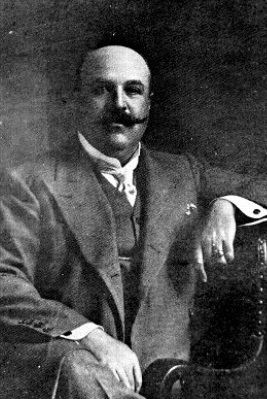El Banco de Campeche
The Banco de Campeche arose out of the branch of the Banco Yucateco. At the general meeting on 21 September 1902 the president, José María Castellot, proposed to break away to form a bank run by local bankers. This bank was granted a concession on 11 February 1903 and founded on 18 June with a capital of 500,000 pesos.
Branch offices were opened in Hecelchakán and Ciudad del Carmen and in Mérida, Yucatán (in September 1906The manager was Emilio Moller, and the cashier Ceferino Gómez, "both being well known in financial circles throughout the state" (El Paso Times, 19 September 1906)).
In 1908 it gave up its rights as a bank of issue and converted into a banco refaccionario. The bank quickly withdrew the notes in circulation and by May 1914 when the liabilities had passed to the Banco Nacional de México, only $6,725 remained outstanding.
American Bank Note Company print runs
The American Bank Note Company printed the following notes. It produced special vignettes for the coat of arms of the city of Campeche (C 865) and a view of its harbour. The first printing, in September 1902, was order F 108ABNC, folder 203, Banco de Coahuila (1906-1931).
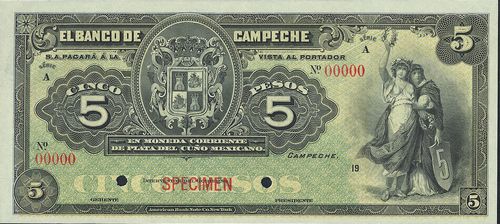
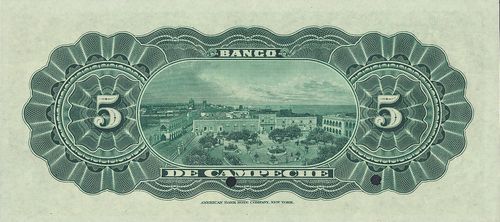 M59p $5 Banco de Campeche specimen
M59p $5 Banco de Campeche specimen
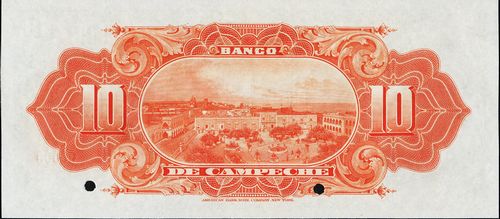 M60p $10 Banco de Campeche specimen
M60p $10 Banco de Campeche specimen
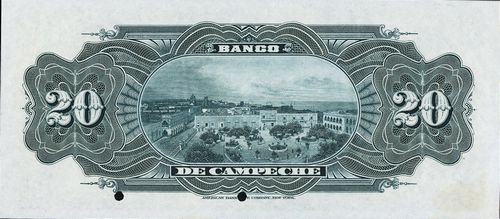 M61p $20 Banco de Campeche specimen
M61p $20 Banco de Campeche specimen
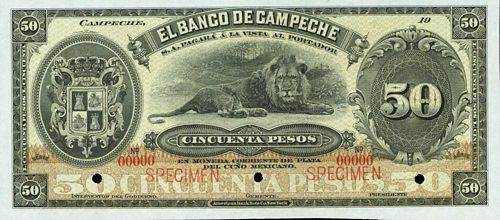
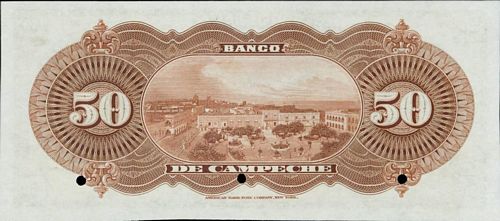 M62p $50 Banco de Campeche specimen
M62p $50 Banco de Campeche specimen
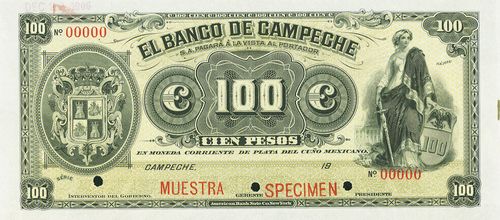
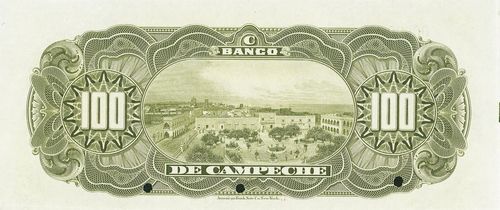 M63p $100 Banco de Campeche specimen
M63p $100 Banco de Campeche specimen
| Date | Value | Number | Series | from | to |
| September 1902 | $5 | 70,000 | A | 00001 | 70000 |
| $10 | 35,000 | B | 00001 | 35000 | |
| $20 | 15,000 | C | 00001 | 15000 | |
| $50 | 6,000 | D | 0001 | 6000 | |
| $100 | 2,000 | E | 0001 | 2000 |
On 8 October 1906, José Castellot, whilst staying at the Waldorf-Astoria in New York, arranged with the ABNC for a second printing (F 996)ibid..
| Date | Value | Number | Series | from | to |
| October 1906 | $5 | 30,000 | F | 00001 | 30000 |
| $10 | 20,000 | G | 00001 | 20000 | |
| $20 | 15,000 | H | 00001 | 15000 | |
| $50 | 9,000 | I | 0001 | 9000 | |
| $100 | 4,000 | J | 0001 | 4000 |
The $5 notes (in box No. 5) and the $10 and $20 notes (in box No. 6) were forwarded, by Adams Express, to the Banco Central Mexicano in Mexico City on 1 February 1907ibid. and the $50 and $100 notes (in box No 7) on 5 Marchibid.. The bank does not seem to have paid for these notes as the ABNC was still seeking payment on 27 February 1908ibid..
When the bank was wound up this whole issue was incinerated on 9 April 1909report of the Interventor Gual, 8 July 1909, Memoria de las Instituciones de Crédito correspondiente al año 1909, vol. 1.
The plates were cancelled by the ABNC on 7 December 1931 (order F 9501)The plates were all made on order F-108. They were:
1 – 6 on 5 pesos face plate
1 – 1 on 5 pesos tint plate #2
1 – 6 on 5 pesos back plate
1 – 4 on 10 pesos face plate
1 – 1 on 10 pesos tint plate #2
1 – 4 on 10 pesos back plate
1 – 4 on 20 pesos face plate
1 – 1 on 20 pesos tint plate
1 – 4 on 20 pesos back plate
1 – 2 on 50 pesos face plate
1 – 1 on 50 pesos tint plate #2
1 – 2 on 50 pesos back plate
1 – 1 on 100 pesos face plate
1 – 1 on 100 pesos tint plate #2
1 – 1 on 100 pesos back plate (ABNC, folder 203, Banco de Coahuila (1906-1931)).
Signatories
The signatories are José Castellot and Adolfo G. Gual as Interventor, Joaquín Lanz Trueba as Gerente and Fernando Berrón Barret and José García Gual as Presidente.
Interventor
| José Felipe Castellot was the brother of José Castellot (see infra). | 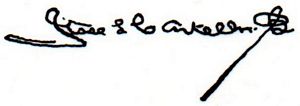 |
|
Adolfo G. Gual seems to have come from Mérida, Yucatán, where he worked for the Singer Sewing Machine Company. He signed the balance sheets from at least 31 August 1904 until the bank converted. He then went back to Mérida. In 1911 he established a water purification plant called the Compañía Electropura de MéridaDiario Oficial, Yucatán, Año XV, Núm. 4330, 1 January 1912 but had died by November 1912 Diario Oficial, Yucatán, Año XV, Núm. 4606, 20 November 1912. |
 |
Gerente
|
Joaquín Lanz Trueba was born in Campeche on 15 April 1868, the son of Joaquín Lanz y Biempica and Teodosia Trueba y de Regil. He administered his hacienda Chumpich, for some time had an important post in the Banco de México and was representative and administrator for several different firms and individuals. Nonetheless, he dedicated a lot of his time to historical studies and published several articles on Campeche. He died on 30 April 1942. |
 |
Presidente
|
Fernando Berrón Barret was a friend and business partner of José Castellot, sharing with him a business called “La Montaña”. He (and his vicepresident Francisco Cano y Cano) resigned on 8 September 1910 as part of an expected wind-up of the bankRevista de Revistas, 10 September 1910. |
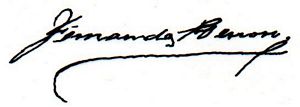 |
|
Gual was Gobernador Interino of Campeche from 9 August 1910 until 25 May 1911. |
 |
Other personages
|
Carleton Beals Carleton Beals, Porfirio Díaz, Dictator of Mexico, Philadelphia, 1932, p. 379 writes "José R. Castellot, also a Casasús client, a voracious, unscrupulous business man with a mattress beard, was installed Governor in representation of the ruling clan, Pablo García and his son Luis García Mezquita. They had promoted a separatist movement of the region from Yucatán in 1857 and controlled the state directly or indirectly for about seventy-five years. Castellot was born in Campeche in 1856. He was cofounder of the Banco Central Mexicano, Banco de Michoacán, Banco de Hidalgo, Banco de Campeche and Banco Agrícola é Hipotecario de México, partner in Hermanos Castellot, cofounder of the Almacenes Generales de Depósito de México y Veracruz, and cofounder of the Cía. Bancaria de Fomento y Bienes Raíces. He was federal deputy from Hidalgo (1898 – 1902), senator from Chiapas (1902 – 1904, 1908 – 1912) and senator from Yucatán (1912 – 1916). He was governor of Campeche for short periods in 1902 and 1903. After the fall of Díaz, he laid low and concentrated on business before becoming President Huerta’s representative in New York and then a conduit between Huerta’s successor Carvajal and the US government. When that failed he moved into exile in New York. He died on 7 April 1938. |
|
|
Fernando was a member of Limantour’s Comisión Monetaria that developed the Ley General de Instituciones de Crédito of 1897. He was the first vice-president of the Banco Central Mexicano, later becoming president, and held positions on the boards of the Banco del Estado de México, Banco Peninsular Mexicano, Banco de Guanajuato, Banco de Michoacán and Banco de Morelos. He was also president of the Compañía Bancaria de Obras y Bienes Raícesorganised in 1905 as Compañía Bancaria de Obras y Bienes Raíces, with change of name to Compañía Bancaria de Fomento y Bienes Raíces in 1909, president of the Mortgage and Credit Foncier Bank of Mexico, vicepresident of the Almacenes Generales de Depósito de México y Veracruz and director of the Caja de Préstamos as well as on the board of insurance companies, industries (the Compañía Fundidora de Fierro y Acero of Monterrey, the Compañía Industrial de Atlixco, the Compañía de las Fábricas de Papel de San Rafael y Anexas, the Compañía Mexicana de Cigarros), and mining, power (the Compañía Hidroeléctrica de Chapala and the Compañía Mexicana de Petróleo El Aguila) and streetcar companies, among others., He was Presidente Municipal of Mexico City from January 1904 until 21 November 1911, a city council that by then was losing government capacity and that, was "politically innocuous, and 'colonized' by the financiers of the regime", headed of course by Pimentel himself. |


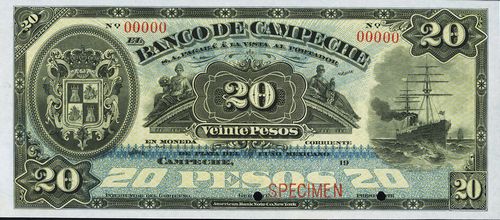
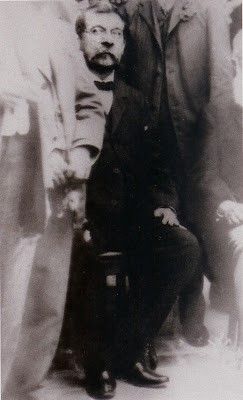 Fernando Berrón Barret
Fernando Berrón Barret José María Castellot Batalla was a landowner, lawyer, banker and politician who benefited from the patronage of Joaquín Casasús and Porfirio Díaz.
José María Castellot Batalla was a landowner, lawyer, banker and politician who benefited from the patronage of Joaquín Casasús and Porfirio Díaz.